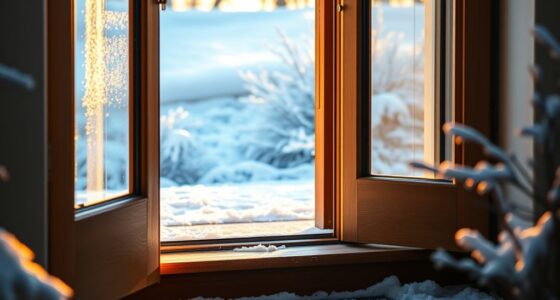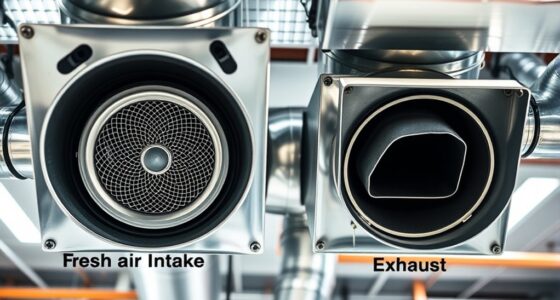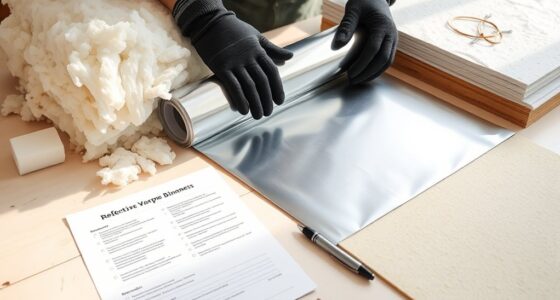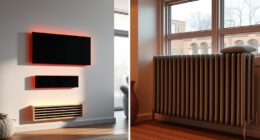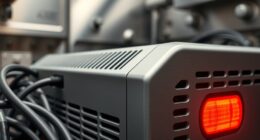To prevent mold, clean high-moisture areas like bathrooms and kitchens weekly using mold-resistant solutions. Use exhaust fans or open windows to improve airflow and lower humidity, keeping levels below 60%. Fix leaks immediately and dry wet spots thoroughly. Avoid clutter that hampers ventilation and always select mold-resistant materials in damp zones. Staying on top of these practices helps maintain a healthy home—discover more proven strategies to keep mold at bay.
Key Takeaways
- Clean high-moisture areas weekly using mold-inhibiting solutions, avoiding infrequent deep cleans that allow mold spores to settle.
- Use exhaust fans and open windows to reduce humidity, instead of neglecting ventilation, which encourages mold growth.
- Fix leaks immediately and dry wet areas thoroughly to prevent persistent moisture that promotes mold development.
- Choose mold-resistant materials and surfaces in bathrooms and kitchens rather than using porous, non-resistant options.
- Regularly monitor indoor humidity below 60% with hygrometers and automate moisture control to maintain an environment less conducive to mold.
How Often Should You Clean Different Areas to Prevent Mold?

To effectively prevent mold growth, you should clean key areas regularly—at least once a week in high-moisture zones like bathrooms and kitchens. Using mold-resistant materials for surfaces and fixtures can slow mold development, reducing cleaning frequency. Incorporate proper ventilation techniques, such as exhaust fans or opening windows, to reduce humidity and keep moisture levels low. Pay special attention to grout, caulking, and under sinks, where mold spores thrive in damp environments. Regular cleaning with mold-inhibiting solutions can prevent spores from settling and growing. Automation technologies that streamline maintenance routines can also help in keeping moisture levels in check and ensuring consistent cleaning schedules. Consistent maintenance combined with mold-resistant materials and good ventilation helps keep your home mold-free and minimizes the need for intensive cleaning over time.
What Are the Best Practices for Keeping Your Home Mold-Free?

Maintaining a mold-free home requires consistent effort and smart practices. Start with ventilation improvements by ensuring your home has proper airflow, especially in high-humidity areas like bathrooms and kitchens. Use exhaust fans or open windows regularly to reduce moisture buildup. Moisture monitoring is vital; keep an eye on humidity levels and aim for below 60%. Use a hygrometer to track moisture and address any issues immediately. Fix leaks promptly and dry wet areas thoroughly. Regularly clean surfaces prone to mold growth with mold-inhibiting solutions. Keep clutter to a minimum to promote airflow and easier cleaning. Engaging in creative practice can also enhance your problem-solving skills, helping you address home maintenance challenges more effectively. By implementing these practices, you create an environment less conducive to mold, safeguarding your home and health.
Frequently Asked Questions
Can Mold Grow in Outdoor Areas Near My Home?
Yes, mold can grow in outdoor areas near your home. Outdoor spores and garden fungi thrive in damp, shaded spots, especially after rain or watering. You might notice mold on mulch, wood, or shady corners. To prevent this, keep the area dry, trim overgrown plants, and ensure good airflow. Regularly inspecting these spots helps you catch mold early and prevents it from spreading closer to your home.
Are Air Purifiers Effective in Mold Prevention?
Did you know that 60% of people believe air purifiers completely prevent mold? In reality, air purifiers can help reduce mold spores, but they aren’t foolproof for mold prevention. Many air purifier myths exist, making it seem like they’re a cure-all. While they improve air quality, you should combine them with proper ventilation and moisture control for effective mold prevention. Relying solely on an air purifier isn’t enough.
How Do I Identify Hidden Mold in My Home?
You can identify hidden mold by paying close attention to signs like a musty smell or discoloration on walls, ceilings, or behind furniture. Mold detection often involves inspecting areas with high humidity or past water damage. Look for hidden spores behind drywall, under carpets, or inside HVAC systems. Using a moisture meter or hiring a professional mold inspection can help uncover these hidden spores that aren’t immediately visible.
What Cleaning Products Are Safest for Mold Removal?
An ounce of prevention is worth a pound of cure. When removing mold, opt for natural cleaning agents like vinegar or baking soda, which are safe and effective. Avoid harsh chemicals that can harm your health. Consider mold resistant paints for future protection. These safe products help eliminate mold without introducing toxins, ensuring your home stays clean and healthy while respecting the environment.
Does Humidity Level Affect Mold Growth Indoors?
Yes, humidity level considerably impacts mold growth indoors. Keep your dehumidifier set between 30-50% to prevent mold spores from thriving. Using mold resistant paint on walls also helps inhibit mold development. When humidity is high, mold can grow quickly, so maintaining proper levels and ensuring good ventilation are essential. Regularly monitor your indoor humidity with a hygrometer to stay in the ideal range and reduce mold risk effectively.
Conclusion
Think of your home as a garden—you’re the gardener tending to its health. Regular cleaning and mold prevention are the watering and sunlight that keep mold at bay. When you stay consistent, your home thrives, free from hidden spores. Remember, a well-maintained space isn’t just about cleanliness; it’s about nurturing a safe, healthy sanctuary. By taking these small steps, you’re planting seeds of protection that grow into lasting peace of mind.


